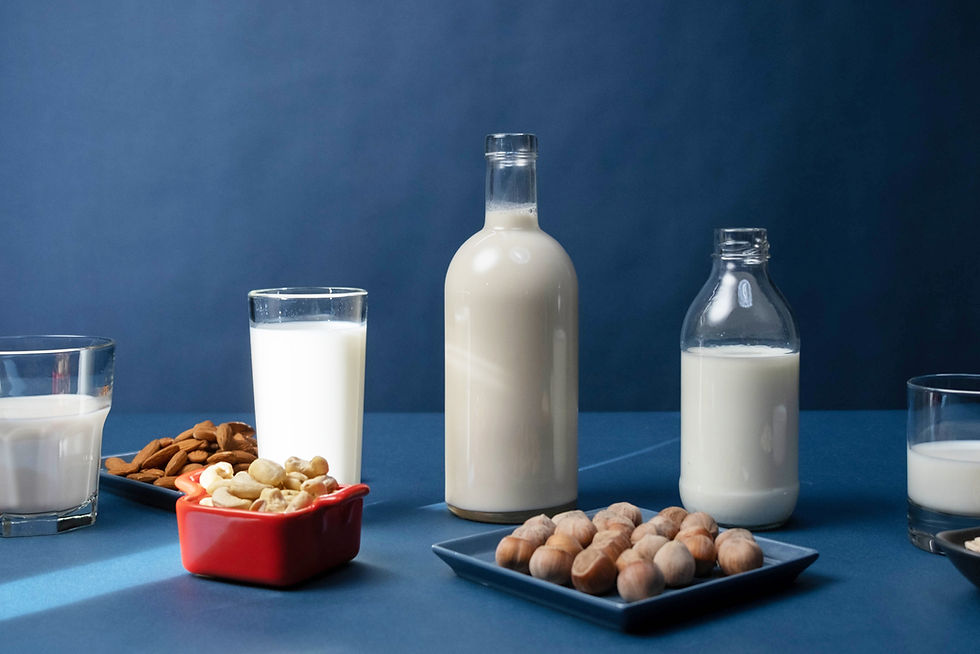Uncovering the Hidden Dairy in Our Food
- Afro-Vegan Society

- Jun 30, 2023
- 4 min read
Updated: Aug 16, 2023

Imagine walking down the grocery aisle, your cart brimming with vibrant, health-conscious choices. You're committed to a vegan lifestyle, and you are confident about your picks. But wait, could there be more than meets the eye in your chosen food items? Could dairy be sneaking into your diet in ways you never anticipated?
"Knowledge is power."
We've all heard this timeless adage, and when it comes to maintaining your vegan lifestyle, it couldn't be more spot-on. Learning to read nutrition labels is not just important - it's essential to becoming an empowered and informed shopper.
What exactly does that mean, you may ask? Well, three examples spring to mind:
Be a Food Detective: Unearth the secrets hiding in your food. Reading labels is your first clue to spotting covert dairy ingredients.
Take Charge: The power is in your hands to decide what fuels your body. You own the choice of what suits your lifestyle and dietary needs.
Eat with a Purpose: Your informed choices do more than just nurture your health. They also take a stand for more climate and animal friendly food choices, making you a change-maker with every bite.
Are you prepared to unlock the information you need to become an expert at deciphering food labels? Together, we'll decode the mystery of hidden dairy ingredients. This will empower you to uphold a vegan lifestyle that's both authentic uncomplicated.
Decoding the Allergen Section on Nutrition Labels
Let's be honest, the average shopper usually simply glances at a product's nutrition label, focusing on things like calories, fat, and maybe sugar. But hidden in plain sight is a section that can be a treasure trove of information for vegans: the allergen section. It's often overlooked, but this little corner of the label can quickly and easily identify if a food product contains any animal ingredients.

Here's a tip: The allergen section is your shortcut to identifying animal-derived ingredients, often revealing the presence of dairy even when it's disguised under less familiar names.
Why is this so? Well, because dairy is a common allergen, it's one of the few ingredients that manufacturers are required to clearly disclose. So, even if milk is listed under an unfamiliar name in the ingredients list, it will be plainly stated in the allergen section. It's like having a secret decoder ring for your grocery shopping!
Getting Familiar with Dairy by Different Names
Dairy is the generic term for animal milks and things made from them. These days there are also many plant-based milks and dairy products, but the terms in this glossary refer specifically to animal-derived ingredients. We've also included a few terms that explain some of the biological responses to digesting dairy (they are indicated with a "*").
Butter: typically a dairy product that is made by churning the cream from animal-based milk until it turns into a spread. Plant-based butter is created using oil.
Casein: a protein found in mammal milk and cheese.
Caseinate: a salt derived from casein.
Casomorphins*: peptides formed during the digestion of casein with an opiate-like response.
Curd: a soft white substance formed by coagulating milk in a process called curdling.
Gelatin: a product derived from collagen taken from animal body parts, typically hides and bones of animals such as cows and pigs. The body parts are boiled, dried, processed with a strong chemical, and lastly filtered until the collagen can be extracted.
Ghee: a clarified butter that has been processed to remove all water content.
Keifer: a fermented food or drink usually made from milk. There are plant-based versions of this food.
Lactase*: a set of enzymes produced in the stomachs of young animals who consume dairy. It is used to coagulate milk, separating it into curds and whey.
Lactose*: a sugar found in milk and milk products. Lactase is typically needed to digest it. The body typically stops producing lactase between two and five years old.
Lactose Intolerance*: a condition due to the the absence of lactase in the system, causing the inability to effectively digest lactose. Symptoms include digestive complications such as bloating, diarrhea, and gas—after you consume foods or drinks that contain lactose. Upwards of 75% of African Americans are lactose intolerant.
Lecithin: a mixture of fats found in food that can be derived from animal foods.
Paneer: a type of cheese made from curdled milk.
Whey: the liquid remaining after milk has been curdled and strained. This can be found in baked goods, protein powders, drink mixes, and other foods.
Yogurt: a food produced by bacterial fermentation of milk. There are plant-based versions of this product.
While it's not essential to memorize all of these terms, it is important to be able to recognize them when they appear so that you can identify and avoid them without hesitation.
Bringing it All Together
Becoming an expert at deciphering nutrition labels and being able to identify hidden dairy ingredients is an essential skill on your vegan journey. With this knowledge, you can stride down grocery aisles with newfound confidence, knowing that your choices align with your values and dietary requirements. Vegan living is more than a diet—it's a commitment to a compassionate lifestyle, and every label you read brings you one step closer to honoring that commitment.
In the comments below, share any dairy related term you've come across while shopping. If you're looking for more support on your vegan journey, visit our Dump Dairy Resource Library for recipes, cooking demos, and education sessions to keep you well fed and well informed!















Comments